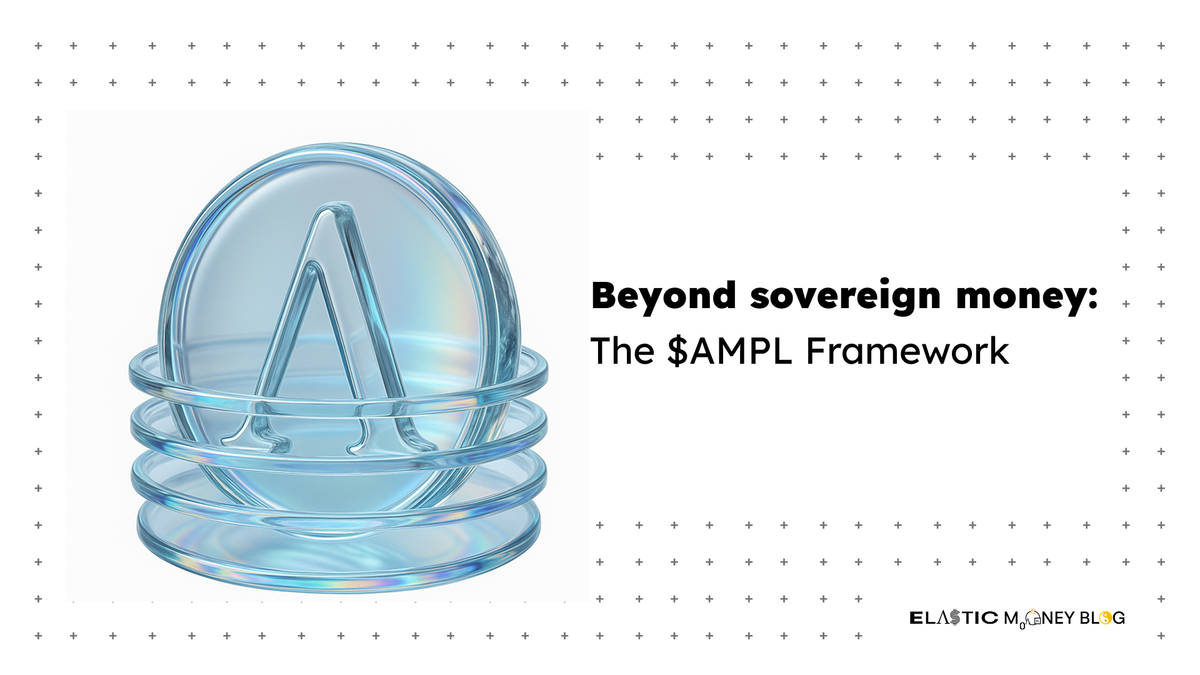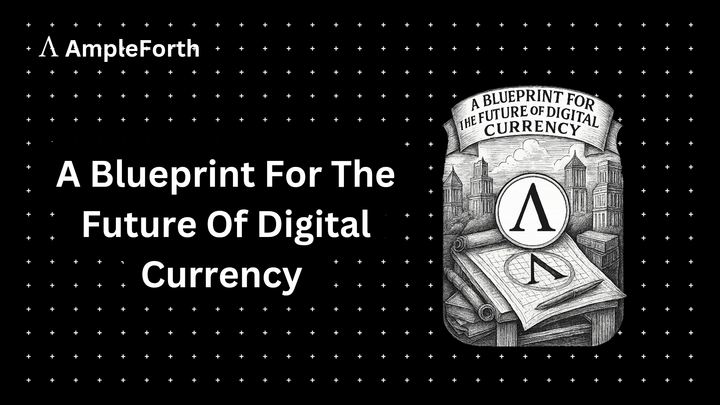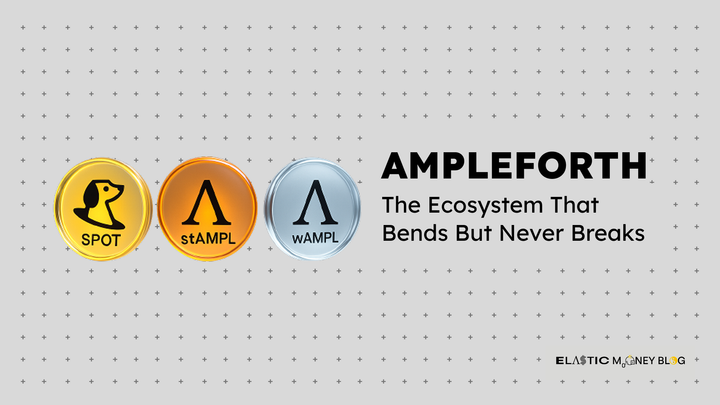Ampleforth & the Rise of Post-Sovereign Finance: elastic money and the future of DATs
Ampleforth’s elastic money powers SPOT, stAMPL, and DATs, delivering neutral collateral and low-volatility yield for post-sovereign, on-chain treasuries.

How Modern Money Works: Eurodollars, Political Discretion, and the Case for Neutral Collateral
Money today is sovereign. It is issued by governments, managed by central banks, and stabilized by debt and bailouts. The collateral of last resort is state paper, things like Treasuries, gilts, and bunds, which are backed not by neutrality but by political discretion. The eurodollar network showed that financial orders can form outside these boundaries, growing into the backbone of global credit. Yet the eurodollar was opaque, fragile, and repeatedly crisis-prone. It revealed that bottom-up orders can thrive, but also that opacity and discretion create systemic vulnerability. But that bottom-up order comes with a price. That state paper is linked to a top-down hierarchy where fumbling political pressure and further opaque mechanisms dictate, or sometimes fail to dictate, precise terms for a complex financial system. And this is the problem.
Ampleforth positions itself as the next stage. It is monetary policy without central planners. Its design is technocratic, invoking rules by code, not committees. Its base unit, AMPL, is a mean-reverting asset. AMPL can further be refined into SPOT and stAMPL for different volatility profiles, either creating enhanced stability and pristine collateral in SPOT or leveraged AMPL called stAMPL. All on blockchains and divorced from political entanglement, this is post-sovereign, requiring no Treasury backing or central bank intervention. It is denationalized, fulfilling Hayek’s vision of competing currencies. And it is a neutral substrate; the smart contract lives on decentralized Ethereum.
To understand what Ampleforth represents, one must return to the essence of finance itself. Finance is not just money, or money on a balance sheet in a ledger somewhere. It has a practical purpose; it is the organization of risk and reward into recognizable and useful roles for economic means. These are important to individuals, institutions, businesses, ventures, and partnerships. Economic systems, from sovereign debt markets to shadow banking, produce traders, arbitrageurs, allocators, and liquidity providers. These are the foundational actors in the system. Ampleforth fully recognizes this and produces a bottom-up, incentive-aligned ecosystem to fuel a network and engine of aligned economic activity. This means order and meaning emerge as different actors take different roles in the ecosystem. The market provides the spectrum of wealth, risk, and opportunity across entities that operate with their own interests in mind. Simply put: finance.
AMPL is elastic money; its supply expands and contracts daily to target purchasing power automatically. From this elastic base emerges a structured financial order: SPOT as senior stability, stAMPL as junior leverage, wAMPL as a composable wrapper. Fast traders act like scalpers, exploiting rebase lag arbitrage. Momentum traders behave like trend riders, profiting from expansion cycles until mean reversion takes hold. Arbitrageurs function as balancers, closing gaps between SPOT and AMPL or between funding flows and equilibrium. Passive allocators resemble portfolio managers, placing capital in SPOT for safety or stAMPL for upside. Liquidity providers play the role of infrastructure, keeping markets liquid and earning fees for it. None of these roles are imposed from above; they arise because the fundamentals of the rules inherent in the AMPL protocol, and adjacent smart contract logic (the vault), make them inevitable.
DATs emerging and AMPL synergy
AMPL is the heart of a decentralized unit of account. Why does this matter, you might ask? A unit of account is the way you measure things, the yardstick that enables financialization. It would make no sense to continue to measure things in fiat when the fiat order is and continues to prove to be breaking down over time. AMPL, inherent to DATs’ functioning, is less competition than ideological synergy, pointing to a future where balance sheets and monetary substrates emerge together into a post-sovereign financial order.
Digital Asset Treasuries, or DATs, are emerging as the collective balance sheets of the crypto economy. DATs are pools of capital governed by protocols, DAOs, or funds that allocate resources across digital assets. They are becoming the war chests and reserve structures of this new order. Introducing them in the context of Ampleforth highlights a striking and promising convergence. DATs aim to preserve and grow value in a neutral, composable way, while Ampleforth offers an incorruptible substrate designed for precisely that function. And with this, the budding emergence of an economy built to sustain itself presents. I believe the two are not separate experiments but parallel expressions of the same strategic impulse: finance organized without sovereign dependence. Where DATs embody the collective will of digital institutions, Ampleforth supplies the transparent mechanics of stability, risk, and incentive to make a more complete, self-sustaining financial ecosystem.
AMPL is the heart of a decentralized unit of account. Why does this matter, you might ask? A unit of account is the way you measure things, the yardstick that enables financialization. It would make no sense to continue to measure things in fiat when the fiat order is and continues to prove to be breaking down over time. AMPL, inherent to DATs’ functioning, is less competition than ideological synergy, pointing to a future where balance sheets and monetary substrates emerge together into a post-sovereign financial order.
Post sovereign sustainability
The outcome is a system that offers both safety and profitability beyond speculation. Safety comes from neutrality, employing no banks, no censorship, and no discretionary counterparties. It comes from insulation against sovereign monetary policy and from risk partitioning that makes shocks absorbable. Profitability arises through volatility harvesting in stAMPL, enrichment flows via the Funding Rate, arbitrage windows across SPOT and AMPL, and compounding network growth during expansionary cycles.
For institutions, this design matters. Sovereign collateral is under growing scrutiny, as decades of hidden leverage and fragile linkages erode trust in nations and the eurodollar system. Regulators admit that crypto’s time has come. Vitalik calls for low-risk DeFi to serve as a foundation. Ampleforth answers both with a technocratic, transparent network successor to the eurodollar order, offering the functionality of collateral-based credit without sovereign fragility.
Ampleforth is strategy on a world stage. It is not merely money, but a bottom-up financial order that is neutral, denationalized, and transparent. It is a system that attracts participation through incentives, generating natural and recognizable financialization through its mechanics, and positions itself as the incorruptible alternative to discretionary fiat.
To engage with it is to adopt both a micro strategy, that is, choosing your roles inside the system: are you a trader, an allocator, a liquidity provider, or an arbitrageur? The more of this kind of positioning, the more we will see the emergence of a macro strategy as well, aligning with a post-sovereign financial order. In a world searching for neutral collateral and resilient credit networks, Ampleforth is not just another asset, it is post-sovereign finance. It is finance beyond nations.




